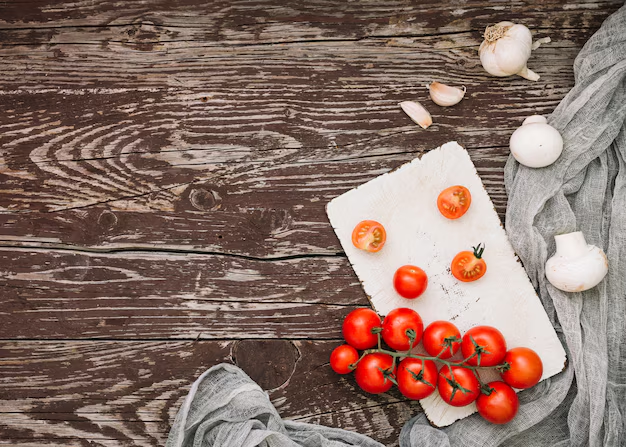Should You Refrigerate Your Tomatoes? The Ultimate Guide to Tomato Storage 🍅
Do you toss your tomatoes into the refrigerator the moment you get home from the store, or do you let them bask in the warm glow of your kitchen counter? It's a debate that balances between taste and practicality, often leaving tomato lovers scratching their heads. While both storage methods have their fans, this comprehensive guide aims to demystify the ideal treatment for your tomatoes, taking you through every angle from flavor preservation to practical value. Let's dive in to discover what’s best for your vibrant reds!
Understanding the Tomato: Nature’s Delicate Balance
Tomatoes are peculiar. They thrive in warmth, yet are often stored in chilly confines. Understanding their delicate balance is crucial in nurturing their maximum potential, invoking both flavor and freshness.
The Scientific Aspect
Tomatoes are ethylene-producing fruits, meaning they emit a gas responsible for ripening. This plays an instrumental role in developing that rich, sugary taste we all love. But it is also what causes them to spoil eventually. Knowing this, you must decide how to prolong shelf-life without sacrificing taste.
Shelf-Life and Storage Conditions
- Room Temperature: Encourages ripening. Best for flavor development within a few days.
- Refrigeration: Slows down the ripening process. Ideal for longer storage.
Tomatoes are happiest between 55 to 70°F. Colder conditions can tamp down their potential, affecting taste and texture.
Why You Should Think Twice Before Refrigerating
Refrigerating tomatoes can be tempting, especially when you want to extend their lifespan. However, refrigeration can often compromise their texture and taste, leaving you with an unappealing, mealy product.
The Drawbacks of Chilling Your Tomatoes
Flavor Degradation: The cold environment suppresses the enzymes responsible for developing the natural taste.
Texture Changes: A lower temperature can cause cell walls to break down, altering that firm bite you crave into a mushy mess.
Nutrient Loss: While not drastic, extended chilling can reduce the nutritional punch associated with fresh tomatoes.
When Refrigeration Makes Sense
Despite the traditional wisdom of leaving tomatoes on the counter, refrigerating them isn’t always the antagonist of taste. Circumstances dictate exceptions:
- Overripe Tomatoes: If your tomatoes are at peak ripeness and you aren't planning to eat them immediately, refrigeration can prevent them from turning to mush.
- Long-Term Storage: If you're planning for more than a week's storage, chilling could outweigh minor flavor loss.
Tips for Optimal Tomato Handling
If you opt to refrigerate, or are forced to due to overripe conditions, there are practices to ensure they retain as much of their essence as possible.
Preparing for Chilling
- Room Temperature Transfer: Let tomatoes sit at room temperature before eating them post-refrigeration. This can revive some lost flavors.
- Separation Strategy: Store them in the refrigerator's crisper drawer with a consistent temperature range to minimize potential fluctuations.
Maximizing Countertop Longevity
- Stem Side Down: Place tomatoes stem side down to minimize moisture loss and stave off spoilage.
- Avoid Moisture Exposure: Keep them dry. Water accelerates decay.
Related Subtopics in Tomato Storage
Pairing with Other Foods:
Tomatoes share storage similarities with other fruits and vegetables, creating an interesting dynamic for your produce shelf.
- Tomatoes and Citrus: Both can sit together but don't benefit from refrigeration.
- Avoid Bananas: They speed up ripening too fast due to high ethylene levels.
- Onion Synergy: While onion aroma isn't ideal for tomatoes, both prefer room temp for flavor preservation.
What About Cooked Tomatoes?
Cooked tomatoes, such as sauces or stews, naturally take a different route. Once heat-altered, they're more stable in chilly conditions. Store in a proper container and chill to maintain flavor and prevent spoilage.
A Summary of Key Takeaways 📋
Here’s a concise table to help you decide where to keep those juicy reds:
| Scenario | Recommended Action |
|---|---|
| Fresh & Unripe | Store on the counter for optimal ripening. |
| Ripe | Consume quickly, or chill for up to 3 days. |
| Overripe | Refrigerate to prevent further spoilage. |
| Cut/Sliced | Refrigerate in an airtight container. |
| Cooked | Store in refrigerator; reheat for flavor. |
Embracing the Tomato Journey
Tomato storage isn't one-size-fits-all. Understanding tomatoes' delicate nature helps you optimize every juicy bite. The allure of fresh, room-temperature tomatoes often outweighs the practicality of longer storage, yet each tomato has its journey from your kitchen to your plate. By balancing flavor, texture, and lifespan, you can enjoy tomatoes in their tastiest forms.
Whether you choose to refrigerate or not ultimately depends on your particular situation. Understanding tomatoes’ biology helps inform when conditions like ripeness and storage period might justify chilling. Let this guide empower you to make informed choices for every tomato - because, after all, life’s too short for bland tomatoes! 🍅
